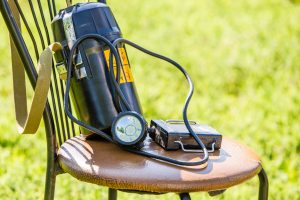Print a Sign-In Sheet | Spanish Version Coming Soon
Battery-powered equipment is commonplace in modern mining operations and often has many advantages over other types of power for mining equipment. However, accidents can occur where miners are blinded or seriously burned by batteries. Many of these accidents are related to charging, installing, removing, or maintaining batteries. The following are some safety tips that one should follow when working with batteries:
- Keep sparks and flames away from the battery.
- Remove jewelry that might make electrical contact and create sparks.
- Wear personal protective equipment (PPE), such as chemical-resistant rubber gloves, aprons, and face shields.
- Batteries should be kept relatively clean and free of excess dust.
- If acid enters the eye, immediately flood with running water for at least 30 minutes. Consult a physician immediately, blindness can result if acid comes in contact with the eye.
- If acid contacts the skin, wash the affected area immediately with plenty of water. Extremely painful burns and scarring may result if acid touches the skin.
- Properly ventilate battery changing stations.
When batteries are being charged, explosive gasses are produced. Heat and sparks can ignite these gasses causing a fire or explosion. The most common way of venting an underground battery charging station to the return is to create an adequate opening in the return side stopping. This allows the gasses created during battery charging to be vented directly into the return.
Also, placing a standard man door in the stopping that can be opened should a fire occur will increase the pull to the return and clear the fresh air side of the fire. Connecting a cable to the door and extending it to an outby position is a simple, inexpensive, and quick way to open the door remotely. Make sure that the cable is located far enough outby to avoid smoke rollback. However, the man door should not be used as a regulator for the ventilation of the battery station.
If you do work around battery charging stations, ensure that all the required firefighting equipment is readily available. If you notice that any firefighting equipment is missing, report it and replace it immediately.
KEMI does not assume liability for the content of information contained herein. Safety and health remain your responsibility. This information is to be used for informational purposes only and not intended to be exhaustive or a substitute for proper training, supervision or manufacturers’ instructions/recommendations. KEMI, by publication of this information, does not assume liability for damage or injury arising from reliance upon it. Compliance with this information is not a guarantee or warranty that you will be in conformity with any laws or regulations nor does it ensure the absolute safety of any person, place or object, including, but not limited to, you, your occupation, employees, customers or place of business.

